
The mid-size 4x4 wagon battle has always been popular in Australia, and you can understand why. With the ability to accommodate a family on adventures all over the country at a purchase price considerably less than that of a LandCruiser, they can be the perfect vehicle for exploring this grand country.
The Toyota Prado is the peerless sales leader in this segment, but when you step down to the next rung on the sales ladder, Isuzu has held a firm hold on second place for a few years now with its MU-X. The next most popular wagon in this class is the Ford Everest and, while it is getting long in the tooth, it is still a great all-roads vehicle.
This year brought us an all-new MU-X that should appeal to a lot more buyers, as it delivers next-level safety and features in an edgy new body shell. We’ve grabbed a top-of-the-range MU-X LS-T and lined it up with the similarly top-spec Ford Everest Titanium to see how the two compare.
While the second-gen MU-X came with a considerable price rise over the previous model, in top-of-the-line trim it’s still almost $10K cheaper than the Ford Titanium – $73,190 versus $63,990. Ford has priced its Everest range closer to the Prado than the other ute-based wagons, but this hasn’t hurt its popularity, even if it doesn’t sell quite as well as the Isuzu wagon.
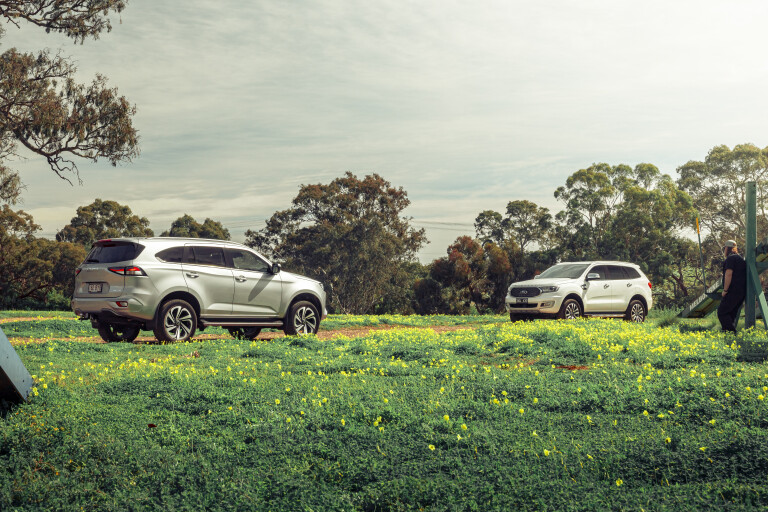
ISUZU MU-X LS-T
POWERTRAIN & PERFORMANCE
ALL 2022 MU-X variants get the latest version of Isuzu’s 4JJ3 3.0-litre four-cylinder engine. It now produces 140kW and 450Nm in line with the same engine in the current D-MAX ute on which the MU-X is based. Like the Everest, it is only available with an automatic transmission, in this case Aisin’s excellent six-speed unit which we’ve always been fans of.
The remainder of the driveline consists of a part-time dual-range transfer case splitting the drive to the axles, which are a live unit at the back and an IFS unit mounted up front. The rear axle has a driver-operated locking differential. The MU-X is also available as a 4x2 model.
Like any other four-cylinder diesel engine, the Isuzu unit is relatively harsh and noisy despite the company’s best efforts to quell the inherent attributes, but it’s never offensive. The increased performance from its uprated outputs is certainly appreciated in the wagon just as it is in the D-MAX ute, even if they fall short of the class leaders in this regard.
The MU-X doesn’t lack for power under everyday driving, although how it would cope at its rated 3500kg towing capacity remains to be seen. In our opinion, neither of these wagons would be particularly comfortable towing that weight and are best kept to less than three tonnes. The Aisin gearbox continues to deliver faultless and precise selection of ratios, never looking for or needing any more gears.

ON-ROAD RIDE & HANDLING
THE MU-X is derived from the D-MAX ute and, like other 4x4 wagons that share the same formula, the ute’s chassis has had its wheelbase shortened and its rear leaf springs replaced by coils to give a more passenger-friendly ride. The ute’s rear drum brakes have also made way for disc brakes.
For Isuzu the platform was an all-new chassis that debuted on the D-MAX in 2020 and was clipped to go under the 2022 MU-X. That includes the new-design double-wishbone front suspension, a stiffer frame and a full suite of safety features.
The suspension is soft and compliant, giving a comfortable ride at the expense of dynamics and steering precision. The chassis absorbs bumps and ruts well but lurches through corners, reflecting its high-riding family wagon design. The inclusion of low-profile tyres on the LS-T might aid the handling a bit but the MU-X is no sports car, nor is it meant to be.
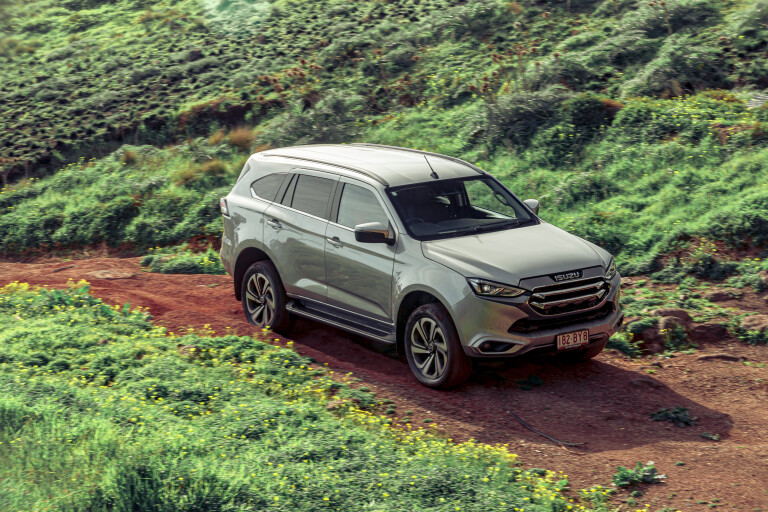
OFF-ROAD
THE D-MAX underpinning means that the MU-X isn’t a bad off-roader by any standard; better in fact than the ute, thanks to the shorter wheelbase improving the ground clearance in between the axles and the coil springs giving a tad more travel in the rear suspension.
The four-wheel drive system is part-time, dual-range carried over from the D-MAX, and a rear differential lock is standard across all 4x4 MU-Xs. This simple system works well off-road, especially with the diff lock engaged. The LS-T struggled to get up our rutted hill without the diff lock in, but scrambled its way up with it engaged.
Controlling the transfer case is done via a dial on the console and, as with all of these electronic systems, you need to take your time when selecting the 4x4 modes. Even when taking all the usual precautions, the MU-X was hesitant to disengage from low range and took a bit of messing around.
The MU-X also has a Rough Terrain button that sharpens the calibration of the electronic traction control, and it works. Once again, pressing this button on the rutted hill helped the MU-X get up it, where otherwise it faltered once a wheel broke traction.
We are left wondering why Isuzu wouldn’t set the ETC calibration this way whenever low range is selected. Maybe the marketing team wanted another gadget to talk about.
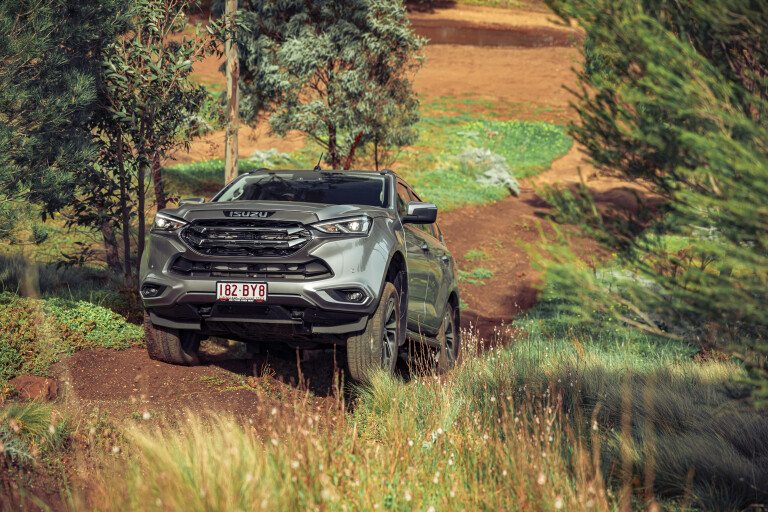
CABIN & ACCOMMODATION
AS the top-of the-range variant, the LS-T comes very well-equipped. It gets the bigger AV screen, wireless CarPlay connection, dual-zone climate control, power adjustable leather seats, and it's the only model in the range to get heated front seats and a tyre-pressure monitoring system (TPMS).
Most of the controls are simple enough and easy to use, but we still don’t like the use of slow-acting buttons for audio controls when tactile dials are easier and faster to use.
The seats are comfortable but the space is narrower than that in the Ford, which is certainly noticeable in the driver’s seat. The second row seat slides fore and aft and offers plenty of space for leg and headroom, while the third row is best left for the little-uns.
The LS-T gets a power tailgate, but there is no sunroof standard on the MU-X as there is on the Ford.
The MU-X gets the full IDAS safety suite including autonomous emergency braking, lane departure warning and prevention, rear cross-traffic alert, post collision braking, turn assist, lane keeping assist, automatic cruise control, traffic sign recognition, forward collision warning and the previously mentioned TPMS.

PRACTICALITIES
THE MU-X has a high 3500kg towing capacity and 5900kg GCM, meaning it'll appeal to those who want to haul heavy trailers. The payload is also a healthy figure at 625kg, so it's good for escapes with the whole family with a few accessories fitted to the car.
The LS-T’s low-profile tyres on 20-inch rims aren’t great for off-road use and probably had a bit to do with the MU-X struggling on our hill climb, but the size of the brake rotors are the same across the MU-X range, meaning you can fit 17- or 18-inch wheels from the lower grades to the LS-T if you want more off-road suitable tyres.
The 235mm of ground clearance and 800mm wading depth are both good for off-road use, but the engine draws its air from a forward-facing outlet above the headlight, so exceeding that wading depth could prove costly. Isuzu does have a factory snorkel available in a range of accessories for the MU-X, and it’s a model that is reasonably well-supported by the major aftermarket accessory manufacturers.
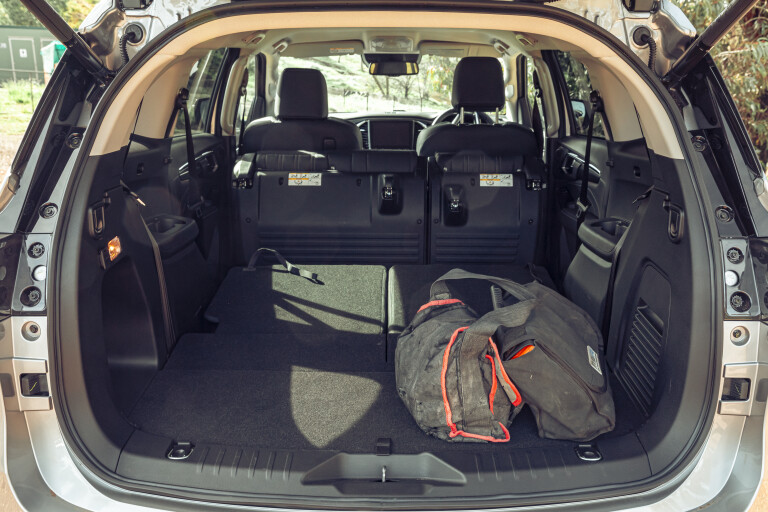
FORD EVEREST TITANIUM
POWERTRAIN & PERFORMANCE
FORD offers a choice of two powertrains in its Everest wagon: the long-serving 3.2-litre five-cylinder diesel engine backed by a six-speed auto transmission, or the more powerful 2.0-litre diesel with a 10-speed auto. While we prefer the characteristics of the old 3.2 in the working-class Ranger ute, we think the higher level of refinement offered by the 2.0 work better in the Everest wagon, which, like the MU-X, is based on its ute stablemate.
The 2.0-litre/10-speed combination is the only one offered in the top-spec Everest Titanium, which we are driving here.
The two-litre engine may be small but it uses a bi-turbo arrangement to deliver some class-leading numbers, with 500Nm of torque on tap and 157kW of power. It’s a peakier power delivery compared to that of the bigger Isuzu engine, but the torque is higher across the rev range.
The 10-speed auto has a ratio for every application to match the engine’s characteristics, however we still found it a bit indecisive under low-throttle applications in suburban driving. This is something we have noted with this transmission in the past. Under full throttle there’s no such hesitation or fault and that 500Nm of torque is felt to the fullest.
Not only is the smaller of Ford’s diesel engines the more refined of the pair, but it’s also more refined than the three-litre mill in the MU-X. It is smoother and quieter when judged from within the cabin; this could possibly be attributed to the 50-per-cent smaller capacity of the four pots in a more modern engine. It also has a more frugal consumption rating – with 7.0L/100km compared to the Isuzu’s 8.3L/100km on the ADR combined scale.

ON-ROAD RIDE & HANDLING
THE Everest hides its light-truck heritage better than the MU-X, delivering an experience that is both more dynamic and refined – something that is not always easy to achieve. You can thank the Australian engineering team for that, with their decades of experience setting up vehicles for Australian roads.
The Ford has a better hold of the road, feeling like it has a lower centre of mass than the Isuzu, and the Watts-link-equipped rear suspension does a superb job of controlling the live rear axle on corrugated dirt tracks.
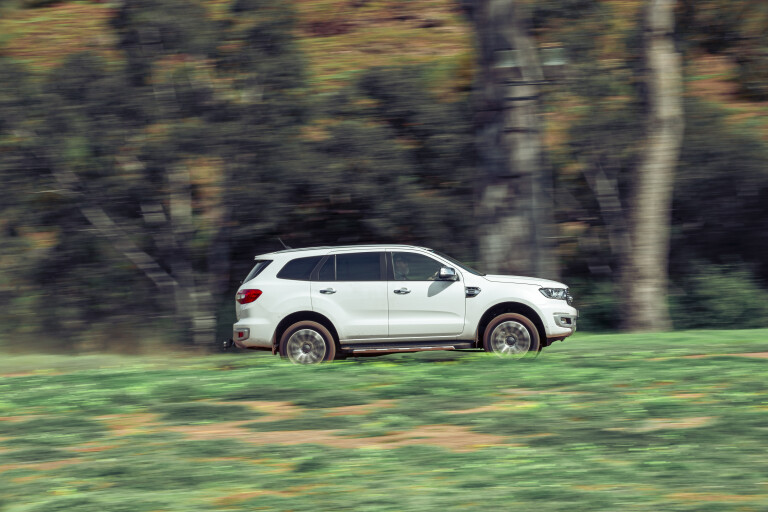
OFF-ROAD
THE work the local engineering team for Ford’s T6 platform, on which the Everest, Ranger and Bronco all ride, comes to fore again when you head off-road in the Everest, with the excellent calibration of the traction control (ETC) system.
This remains active across the front axle when the rear diff lock (RDL) is engaged – not all 4x4 vehicles keep this function and it is most important. Even without the RDL engaged, the ETC did a great job of getting the Everest up our rutted hill climb.
The Everest’s 4x4 system is on-demand, meaning it is partially AWD all the time, with the amount of drive going to the front axle varied depending on the road-surface grip and the setting in the Multi Terrain system (MTS). This is great for driving on wet or varied surface roads, but a negative is that the centre differential can’t be fully locked to give 50:50 drive front to rear when off-road. Selecting the more aggressive ‘Rock’ setting in the MTS goes someway to address this, but when in the Rock setting, the transmission holds first gear and doesn’t upshift.
An advantage of Ford’s 10-speed transmission is its super low 4.696:1 first gear, which in turn gives a handy 42.32:1 overall crawl ratio for better off-road control and engine braking.

CABIN & ACCOMMODATION
THE Everest's cabin is wider and the driver’s seat offers more space and comfort than the MU-X. However, the cabin does show the age of the Everest, with its AV screen being smaller than what we’ve become accustomed to in recent times. The steering column is also only adjustable for height and not reach, as is the case in the MU-X.
The Ford has nice, big, easy-to-use dials for the audio controls, but it still has miniscule buttons for the climate control temperature settings which are hidden away low in the centre stack. If you look hard enough you’ll also find the controls for the seat heaters tucked down here.
The CarPlay connection for Ford’s Sync system requires a USB cable, and you can remotely connect to the car via an app on your phone. A sunroof is standard on the Titanium, as are powered third-row seats; although, I can’t imagine why you would need them to be powered. Likewise with the power tailgate, which on the Ford can be operated hands-free with a wave of your foot beneath a sensor on the car.
Ford updated the Everest’s safety kit a couple of years back and it now includes Autonomous Emergency Braking (AEB) with pedestrian protection, emergency brake assist, hill launch assist, lane departure warning, trailer-sway control, lane keeping aid, TPMS, and traffic sign recognition. About the only safety feature that the MU-X has over the Everest is its rear cross-traffic alert.
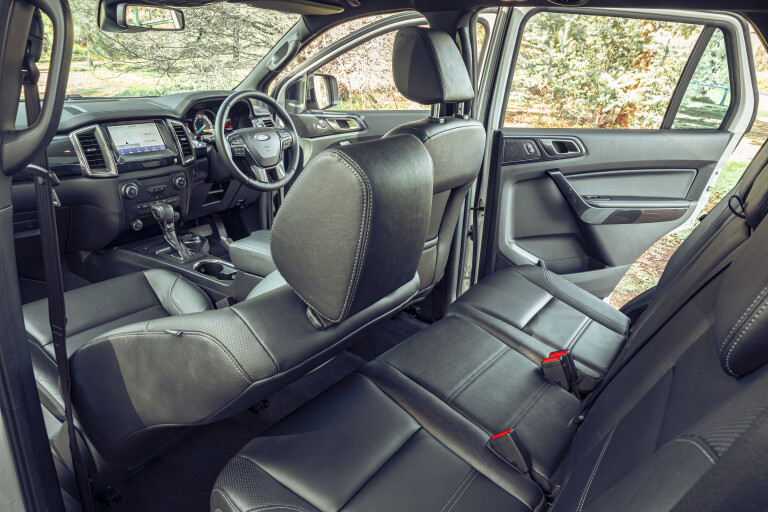
PRACTICALITIES
THE Everest’s more sensible 3100kg towing capacity won’t win it any friends in the big caravan brigade, but it's more realistic as to what you should expect from cars this size. The 623kg payload is on par with the MU-X (just think how much better it could be without all those electric motors for the powered seats, tailgate and sunroof) so both carry a family or cargo equally as well.
Like the MU-X, the Everest has an 800mm wading depth and the engine takes its air from a forward-facing duct above the grille. We have heard of an instance where one of these engines copped a gutful of water crossing a creek, which is disappointing as the 3.2L engine gets its air in a better system from inside the ’guard.
Ford’s 2.0-litre diesel uses AdBlue/SCR as part of its emissions system, so that’s also something to be mindful of; although not considered a negative.
The Everest Titanium comes with the same size 265/50R20 tyres as on the MU-X, but like the MU-X, you can fit the smaller wheels off a lower grade Ford to allow more sensible tyre fitment. In fact, Ford even offers an 18-inch wheel with all-terrain tyres option for the smart buyer when ordering a Titanium. There is also a range of genuine Ford accessories available including snorkel, nudge bar, towing kit, and a range of Rhino-Rack roof-carrying devices. The Ford is well-supported by the aftermarket accessory mobs as well.

IN SUMMARY
AT the end of the day it’s going to be the drive-away price that swings you toward the Everest or the MU-X, and the $10K difference before you start dealing is a big factor.
The Ford does feel like it’s worth more money – it’s more refined, more powerful, bigger inside, and it never gives away its light-truck underpinnings as the MU-X does at times. The Ford feels more like a quality SUV than a wagon, riding on a ute chassis; but, again, it is feeling its age.
An all-new Everest is due from Ford in the back half of 2022, and spy photos of the new models out testing have already been seen.
The MU-X, on the other hand, reminds you that it’s based on the D-MAX pick-up in the way its cabin feels, and the rattle of the diesel engine is more evident within it. While it might not feel as luxurious, it does feel newer in terms of its design and levels of equipment, having a few features the Everest Titanium misses out on including reach adjustment for the steering wheel and safety tech like the rear cross-traffic alert system.



COMMENTS